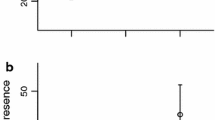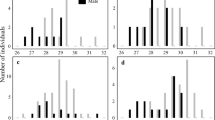Abstract
The Amazon molly, Poecilia formosa, is an all-female species that reproduces by gynogenesis, i.e., it relies on sperm of males of closely related species to trigger embryogenesis. Sperm is supplied by males of P. latipinna and P. mexicana. Amazon mollies live in sympatry with at least one of these species, a few populations live in sympatry with two sperm-donor species. As P. formosa is sperm dependent, it needs mechanisms for species and mate recognition. To investigate the effect of rearing conditions on sexual preferences of Amazon mollies, we raised Amazon mollies in sympatry with P. latipinna and P. mexicana males. We used simultaneous choice tests to determine the effect of age on female sexual preferences. Immature Amazon mollies do not exhibit a preference if given a choice between a P. latipinna and a P. mexicana male, whereas adult P. formosa do have a preference for the P. latipinna male. We used two different stimuli in this study, live males and videotapes of males.
Similar content being viewed by others
References cited
Ali, M.A. & W.R.A. Muntz. 1975. Electroretinography as a tool for studying fish vision. pp. 159–167. In: M.A. Ali (ed.) Vision in Fishes, Plenum Press, New York.
Avise, J.C., J.C. Trexler, J. Travis & W.S. Nelson. 1991. Poecilia mexicana is the recent female parent of the unisexual fish Poecilia formosa. Evolution 45: 1530–1533.
Bennett, A.T.D., I.C. Cuthill & K.J. Norris. 1994. Sexual selection and the mismeasure of colour. Amer. Nat. 144: 848–860.
Bisazza, A., A. Pilastro, R. Palazzi & G. Marin. 1996. Sexual behaviour of immature male eastern mosquitofish: a way to measure intensity of intra-sexual selection? J. Fish Biol. 48: 726–737.
Clark, D.L. & G.W. Uetz. 1990. Video image recognition by the jumping spider, Maevia inclemens (Araneae: Salticidae). Anim. Behav. 40: 884–890.
Clark, D.L. & G.W. Uetz. 1992. Morph-independent mate selection in a dimorphic jumping spider: demonstration of movement bias in female choice using video controlled courtship behaviour. Anim. Behav. 43: 247–254.
Darnell, R.M. & P. Abramoff. 1968. Distribution of the gynogenetic fish, Poecilia formosa, with remarks on the evolution of the species. Copeia 1968: 354–361.
D'Eath, R.B. & M. Stamp Dawkins. 1996. Laying hens do not discriminate between video images of conspecifics. Anim. Behav. 52: 891–902.
Evans, C.S. & P. Marler. 1991. On the use of video images as social stimuli in birds: audience effects on alarm calling. Anim. Behav. 41: 17–26.
Guthrie, D.M. & W.R.A. Muntz. 1993. Role of vision in fish behaviour. pp. 89128. In: T.J. Pitcher (ed.) Behaviour of Teleost Fishes, Chapman & Hall, London.
Hubbs, C.L. & L.C. Hubbs. 1932. Apparent parthenogenesis in nature in a form of fish of hybrid origin. Science 76: 628–630.
Huntingford, F.A. 1989. Development of behaviour in fish. pp. 57–84. In: T.J. Pitcher (ed.) Behaviour of Teleost Fishes, Chapman & Hall, London.
Körner, K.E., O. Lütjens, J. Parzefall & I. Schlupp. 1999. The role of experience in mating preferences of the unisexual Amazon molly. Behaviour (in press).
Marler, C.A. & M.J. Ryan. 1997. Origin and maintenance of a female mating preference. Evolution 51: 1244–1248.
Nicoletto, P. & A. Kodric-Brown. 1999. The use of digitally-modified videos to study the function of ornamentation and courtship of the guppy, Poecilia reticulata. Env. Biol. Fish. (in press).
Rosenthal, G.G., C.S. Evans & W.L. Miller. 1996. Female preference for dynamic traits in the green swordtail, Xiphophorus helleri. Anim. Behav. 51: 811–820.
Roster, N.O., D.L. Clark & J.C. Gillingham. 1995. Prey catching behavior in frogs and toads using video-simulated prey. Copeia 1995: 496–498.
Rowland, W.J. 1989. Mate choice and the supernormality effect in female sticklebacks (Gasterosteus aculeatus). Behav. Ecol. Sociobiol. 24: 433–438.
Rowland, W.J. 1999. Studying visual cues in fish behavior: a review of ethological techniques. Env. Biol. Fish. 56: 287–307 (this issue).
Rowland, W.J., K.J. Bolyard, J.J. Jenkins & J. Fowler. 1995a. A video playback experiment on stickleback mate choice: female motivation and attentiveness to male color cues. Anim. Behav. 49: 1559–1567.
Rowland, W.J., K.J. Bolyard & A.D. Halpern. 1995b. The dual effect of stickleback nuptial coloration on rivals: manipulation of a graded signal using video playback. Anim. Behav. 50: 267–272.
Ryan, M.J. 1990. Sexual selection, sensory systems and sensory exploitation. Oxford Surveys in Evolutionary Biology 7: 157–195.
Ryan, M.J. & A. Keddy-Hector. 1992. Directional patterns of female mate choice and the role of sensory biases. Amer. Nat. (Suppl.) 139: 4–35.
Schartl, M., B. Wilde, I. Schlupp & J. Parzefall. 1995. Evolutionary origin of a parthenoform, the Amazon molly, P. formosa, on the basis of a molecular genealogy. Evolution 49: 827–835.
Schlupp, I., J. Parzefall & M. Schartl. 1991. Male mate choice in mixed bisexual/unisexual breeding complexes of Poecilia (Teleostei; Poeciliidae). Ethology 88: 215–222.
Schlupp, I., C. Marler & M.J Ryan. 1994. Benefit to male sailfin mollies of mating with heterospecific females. Science 263: 373–374.
Schlupp, I. & M.J. Ryan. 1996. Mixed-species shoals and the maintenance of a sexual-asexual mating system in mollies. Anim. Behav. 52: 885–890.
Tinbergen, N. & A.C. Perdeck. 1951. On the stimulus situations releasing the begging response in newly hatched herring gulls (Larus argentatus Pont.) Behaviour 3: 1–39.
Turner, B.J. 1982. The evolutionary genetics of a unisexual fish, Poecilia formosa. pp. 265–305. In: C. Barigozzi (ed.) Mechanisms of Speciation, Alan R. Liss, New York.
Uetz, G.W., W.J. McClintock, D. Miller, E.I. Smith & K.K. Cook. 1996. Limb regeneration and subsequent asymmetry in a male secondary character influences sexual selection in wolf spiders. Behav. Ecol. Sociobiol. 38: 253–257.
Author information
Authors and Affiliations
Rights and permissions
About this article
Cite this article
Landmann, K., Parzefall, J. & Schlupp, I. A Sexual Preference in the Amazon Molly, Poecilia formosa. Environmental Biology of Fishes 56, 325–331 (1999). https://doi.org/10.1023/A:1007501822540
Issue Date:
DOI: https://doi.org/10.1023/A:1007501822540




